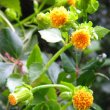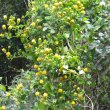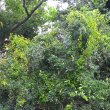| Botanical Name |
|
| Family |
Asteraceae - The daisy family. |
| Pronunciation |
sen-NEESH-shee-oh kwin-kway-LOH-bus |
| Common Name(s) |
|
| Plant Group |
- Climber / Creeper Climber: a plant that climbs using tendrils or if given support.
Creeper: a plant running along the ground, often rooting as it goes.
|
| Plant Size |
- Medium to Large
| Tree | 15m to 20m |
| Shrub | 2m to 3m |
| Perennial/ground cover | 60cm to 75cm |
| Bulb | 60cm to 1m |
| Succulent | 60cm to 1m |
|
| Position |
- Canopy Shade Canopy shade is found below closely grown trees where some light filters through. Ideal for the protection of herbaceous plants.
- Deep / Full Shade Shade below spreading evergreen trees where sun's rays are unable to penetrate the canopy at any time. For light sensitive plants
- Light or Dappled Shade Found below trees with sparse, open foliage. Ideal for the protection of herbaceous plants.
- Partial Shade The area is in shade for part of the day and in full sun for part of the day.
|
| General Information |
- Drought Tolerance: Moderate The plant is moderately adapted to arid conditions and can survive short periods of drought and high temperatures without extra water.
- Evergreen Plants that have leaves all year round.
- Frost: Tender A plant that will not survive any frost or low winter temperatures.
- Sand tolerant Plants adapted to survive in nutrient poor, very sandy soils.
- Water Wise Plant species originating from low rainfall regions that require less water to survive and thrive than other plant species.
|
| Specific Information |
This semi-succulent climber grows much like Senecio tamoides, the canary creeper. Its long shoots twine through bushes and trees to reach the sunlight. It blooms profusely, often covering the bush with blooms.
|
| Ad Break |
|
| Flowers |
| Description |
|
| Season |
- Winter to Spring Plants will seldom bloom for the entire season as given in the list, but should flower during a period within these parameters.
|
| Colour |
|
| Growth Rate |
- Moderate to Fast Specifying growth rate can be very misleading as there is considerable variation of growth rate depending on type and species of plant, available water, supplementary feeding, mulching and general care, as well as the plants suitability and adaptability to the garden environment.
|
| Plant Uses |
- Attracts bees, butterflies or other insects This plant attracts insects which can be food for birds or other creatures in your garden.
- Attracts Birds This plant will attract birds.
- Boundary A plant useful for planting around the edges of the property to form a green or colourful backdrop, an impenetrable hedge, to hide walls or create privacy.
- Suitable for coastal gardens Plants adapted to dry, sandy soil, forceful wind, limited rainfall and intense sunlight.
- Wild Garden An indigenous garden planted for the benefit of wildlife and birds. Provides food, water, a variety of mini-biomes and no poisonous chemicals are used.
|
| Distribution and Habitat |
Eastern Cape, KwaZulu-Natal, Western Cape, in coastal bush and the edges of forests
|
| Planting Suggestions |
Plant in well drained soil beside a tree or shrub. Add some compost or fertiliser to encourage lush growth. Keep moist until established, after which it can be weaned until completely water wise. Once established, growth is fast.
|
| Medicinal Uses |
The Xhosa make a mixture of roots, leaves and soil from near the roots which is then smeared on the face to guard against an evil spell, when a person has been seen by, or has seen iChanti, the water snake. The root is also used to relieve hiccoughs.
|
| Ad Break |
|







Discuss this plant
Share knowledge, ask a question or give an experience.